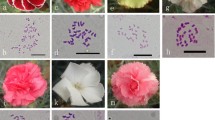Summary
The kinds and sites of sterility and inviability were noted in induced tetraploids of threeIpomoea species, and of hybrids ofIpomoea lacunosa withI. trichocarpa. Tetraploids were somewhat less fertile than diploids, but seeds were normal appearing and ususally viable. Hybrids were much less fertile. Hybrid sterility occurred as pollen abortion, pollen germination failure, and in failure of pollen tube growth. Small and underdeveloped seeds failed to germinate. The sterility of hybrids (but not of tetraploids) is thus very similar to that of the hexaploid sweet potato. Sterility suggests developmental inbalance, which is probably due to genic and perhaps minor chromosomal differences among the parent species of the sweet potato. Hybrid sterility of the sweet potato may have been fixed by polyploidy, and thus may be impossible to eliminate.
Similar content being viewed by others
References
Burnham, M., 1967. Ovule number as a factor in low seed set of certain sweet potato clones. Proc. Am. Soc. Hort. Sci. 90:313–315.
Jones, A., 1965. Cytological observations and fertility measurements of sweetpotato (Ipomoea batatas (L.)Lam). Proc. Am. Soc. Hort. Sci. 86:527–537.
Jones, A., &Deonier, M. T., 1965. Interspecific crosses amongIpomoea lacunosa, I. ramoni, I. trichocarpa, andI. triloba. Bot. Gaz. 126:226–232.
Jones, A. &Kobayashi, M., 1968. Derived polyploids of section Batatas genusIpomoea. Proc. Am. Soc. Hort. Sci. 93:497–501.
Lower, R. L. &Johnson, K. W., 1969. Observations on sterility of induced autotetraploid watermelons. J. Am. Soc. Hort. Sci. 94:367–369.
Martin, F. W., 1968. The system of self-incompatibility inIpomoea. J. Hered. 59: 262–267.
Martin, F. W. &Cabanillas, E., 1966. Post-pollen germination barriers to seed set in the sweet potato. Euphytica 15:404–411.
Martin, F. W. &Ortiz, S., 1966. Germination of sweet potato pollen in relation to incompatibility and sterility. Proc. Am. Soc. Hort. Sci. 88:491–497.
Randolph, L. F., 1941. An evaluation of induced polyploidy as a method of breeding crop plants. Am. Nat. 75:347–363.
Stebbins, G. L., 1958. The inviability, weakness, and sterility of interspecific hybrids. Adv. Genet. 9:147–215.
Wedderburn, M. M., 1967. A study of hybridization involving the sweetpotato and related species. Euphytica 16:69–75.
Author information
Authors and Affiliations
Rights and permissions
About this article
Cite this article
Martin, F.W. Sterility in some species related to the sweet potato. Euphytica 19, 459–464 (1970). https://doi.org/10.1007/BF01902920
Received:
Issue Date:
DOI: https://doi.org/10.1007/BF01902920




